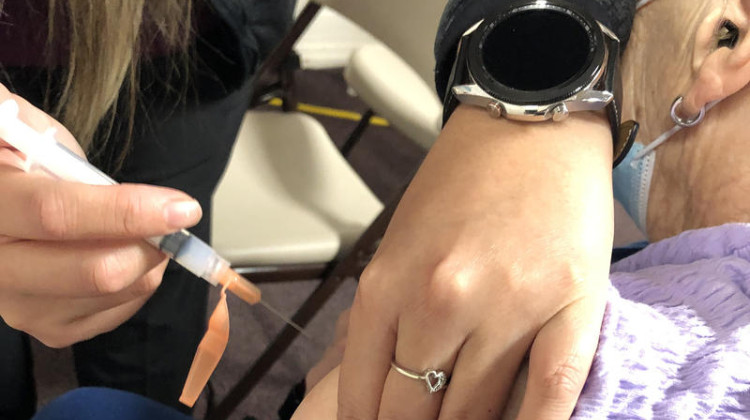
One expert in Indiana expects to see another wave of COVID-19 infections during late spring based on past patterns.
Rebecca Green / WBOIThe newest update to the COVID-19 vaccine reached pharmacies as infections in Indiana began to rise. Members of our audience had questions about the COVID-19 vaccine, tests and variants.
We received these questions through the Indiana Two-Way – a weekly text group that provides news updates and asks questions – to inform our reporting. To join, text the word “Indiana” to 765-275-1120.
If I’ve already had COVID-19, do I still need a vaccine?
As COVID-19 continues to mutate, the vaccine is updated to target more recent strains or variants. Pfizer-BioNTech and Moderna COVID-19 vaccines began distributing the most recent version of the COVID-19 vaccine at the end of August.
Dr. Scott Stienecker, a fellow for the Society for Health Care Epidemiology and the medical director for infection prevention at Parkview Health Systems, said getting a vaccine right after a previous vaccination or active COVID-19 infection doesn’t have any benefit.
“We know that immunity wanes and the immunity will wane depending on how old you are, your underlying immune system functioning, but all of these vaccines are going to wane over time,” Stienecker said. “Usually that means that you're bulletproof after you get vaccinated or infected for somewhere around a good month, maybe two.”
Stienecker said for most people, immunity will decrease to the point where they’re more easily reinfected around six months after their last vaccination or infection.
What makes the new vaccine different?
As immunity wanes, people may seek out what is known as a “booster” shot. A booster is the same vaccine given to someone again to stimulate your immune system.
“The newest variants are only covered or are recognized by our immune system, providing an immunity of 17 percent or so from previous vaccinations and infections,” Stienecker said.
Stienecker said this version of the vaccine is more of an update than a booster, which increases the amount of protection it provides.
“In this case, a new vaccine for COVID is different because we’re looking at different variants, so it’s not a repeat of the same vaccine that you got last year,” Stienecker said. “It's now developed against something that's a little bit new and different.”
The updated vaccines now target a newer variant that’s a member of the omicron family that became more prominent during the summer.
How are the new variants different or the same from the previous variants?
Stienecker said the significant differences between the original strain of COVID-19, the delta and omicron variants – and the variants derived from them – comes down to how the variant interacts with our body’s cells.
When a virus gets into a person’s body, it travels along the surface of cells until its proteins can bind with receptors – which are called binding sites. Stienecker said the binding sites for the original strain, delta and omicron variants are “dramatically different.”
“It's pretty interesting that as it mutates, the binding sites change. And as those binding sites change, the–the symptoms change,” he said.
Stienecker said mutations are inherently a part of viruses – especially ones that infect so many people. He said variants are “trying to reproduce themselves” and the strains mutate to kill off what doesn’t work to evade the body’s immune system.
“And if you have thousands, tens of thousands, millions of people infected in the United States a year, there's just an ongoing driving pressure towards that mutation,” Stienecker said.
The strains targeted by the available vaccines are all omicron variants, which Stienecker said is “giving a lot more, sore throat, runny nose, runny eyes, kind of a symptom” compared to the delta variant which was associated with a lot more pneumonia-like effects. It’s also why experts recommend retesting when you have COVID-like symptoms.
Stienecker said there haven’t been any significant changes in the incubation period or the duration of the symptoms between variants.
But, do I need the boosters or updates?
Experts recommend that if someone is eligible, they should get the updated vaccine.
For the Moderna or Pfizer-BioNtech vaccines, that’s anyone older than 6 months. For the Novavax vaccine, that’s anyone 12 years or older.
The boosters and updates can be especially important for anyone who is considered high risk. People are considered high risk if they have a history of being immunocompromised, are 65 or older, or have other underlying health problems.
“Those folks should really pay attention to it and take advantage of the updates and boosters as they can,” Stienecker said.
For people who aren’t considered high risk, Stienecker said it becomes more of a personal choice based on what types of risks they want to take. He expects boosters and updates to become a regular part of limiting infections.
“It's pretty clear to me that we're probably going to need an update on a yearly basis for those who are at risk for severe disease, those who are in health care. And those who don't want to burn PTO because they got a COVID infection that takes them out of work for 10 days when they could have avoided it,” Stienecker said.
The boosters and updated vaccine can also be an important part of avoiding long COVID, which Stienecker said can affect 12 to 15 percent of people.
“This virus causes lots of trouble, even for those people who don’t require hospitalization,” Stienecker said.
Long COVID can lead to long-term health impacts, including accelerating heart disease and other cardiovascular conditions.
How do I sign up for a vaccine?
Go to your local pharmacy or vaccines.gov to find a location near you. Major pharmacy chains, including CVS, Rite Aid and Walmart have had the vaccines available for a few weeks.
It’s a little easier to find Moderna and Pfizer vaccines. If you’re looking for a Novavax vaccine provider specifically, you can find one through their online tool.
Are COVID-19 vaccines still covered by insurance?
Most insurance plans will cover COVID-19 vaccines at no additional cost, similar to flu shots.
Children eligible for the Vaccines for Children program can receive the vaccine from providers enrolled in that program. The federal program provides vaccines at no cost to children where inability to pay acts as a barrier. Those looking to enroll in the program can contact the Indiana Department of Health Immunization division by emailing enrollments@health.in.gov or calling (800)701-0704.
What are the side effects of the vaccine?
After getting vaccinated, you might have some side effects, which are normal signs that your body is building protection.
Common side effects are pain, redness, and swelling in the arm where you received the shot, as well as tiredness, headache, muscle pain, chills, fever, and nausea throughout the rest of the body.
The CDC has some helpful guidance (and digital editor tested, the washcloth actually works) on how to help mitigate your vaccine symptoms.
Join the conversation and sign up for the Indiana Two-Way. Text "Indiana" to 765-275-1120. Your comments and questions in response to our weekly text help us find the answers you need on statewide issues.
What’s in the vaccines?
The FDA lists six ingredients in the Pfizer-BioNTech vaccine – mRNA, lipids ((4-hydroxybutyl)azanediyl)bis(hexane-6,1-diyl)bis(2-hexyldecanoate), 2[(polyethylene glycol)-2000]-N, N-ditetradecylacetamide, 1,2-distearoyl-sn-glycero-3-phosphocholine, and cholesterol), tromethamine, tromethamine hydrochloride and sucrose.
Basically, that’s three types of fats, cholesterol, sugar, along with tromethamine and tromethamine hydrochloride – which are used as stabilizers in the mRNA vaccines.
For the vaccine approved for kids 6 months to 4 years old, it also contains sodium chloride – which is just salt.
The Moderna vaccine’s ingredients are listed as: mRNA, lipids (SM-102, polyethylene glycol [PEG] 2000 dimyristoyl glycerol [DMG], cholesterol, and 1,2-distearoyl-sn-glycero-3-phosphocholine [DSPC]), tromethamine, tromethamine hydrochloride, acetic acid, sodium acetate trihydrate and sucrose.
That’s four different fats, salt, sugar, tromethamine, tromethamine hydrochloride and acetic acid.
Both the Pfizer-BioNTech and Moderna vaccines use mRNA to deliver a cheat code to your body’s immune system, without giving an inactive or a live but weakened version of the virus.
What about the Novavax vaccine?
The Novavax vaccine does not use mRNA technology. Instead, it takes a weakened version of the COVID-19 variant from winter 2023 produced in a fall armyworm with proteins from a soapbark tree.
Other ingredients include cholesterol, phosphatidylcholine, potassium dihydrogen phosphate, potassium chloride, disodium hydrogen phosphate dihydrate, sodium chloride, disodium hydrogen phosphate heptahydrate, sodium dihydrogen phosphate monohydrate and polysorbate 80.
Which are three types of salts, two types of food additives as stabilizers, cholesterol and one fat found naturally in soy and eggs.
The vaccine may also contain small amounts of baculovirus, and insect cell proteins and DNA.
I have had allergic reactions in the past to vaccinations – can I still get the COVID-19 vaccine?
If you’ve had allergic reactions to vaccines in the past, you should talk to your primary care provider about what vaccine would work best for you.
People who have had severe allergic reactions may need to be monitored after receiving the vaccine. Polyethylene glycol – which is in both Moderna and Pfizer-BioNTech vaccines – has been pointed to as what has triggered some anaphylaxis. Novavax also contains a common food additive – polysorbate – which people may be allergic to.
The most common allergic reaction – especially in flu shots – are in people with egg allergies. The most common flu vaccines are developed with egg-based technology, but the FDA and CDC said common food allergies and medicines shouldn’t prevent most people from receiving the vaccine. If you have any questions or concerns, talk to a medical professional and bring up your concerns to your pharmacist when getting vaccinated.
What if I’m immunocompromised or taking medications that affect my immune system?
The FDA guidance says you should talk to your primary care physician and make that decision with them.
They’ll likely give you the OK, but be sure to bring up these concerns with your doctor to make an informed decision. If your doctor says it’s OK, FDA guidance says to give your vaccine provider a heads up.
Are over-the-counter tests still effective with the newer variants?
COVID-19 tests focus on the areas of the virus that don’t tend to change or mutate, meaning they’re just as effective. However, how people should test has changed with newer variants.
Stienecker said when the omicron family became prominent, experts noticed that people could become symptomatic, but not test positive immediately.
“We now recommend that if you have COVID-like symptoms and you get tested and you’re negative, you should retest again in 48 hours,” Stienecker said.
Stienecker said people should still test immediately when they have symptoms — even just a runny nose or itchy eyes. He also says it’s important to take precautions while waiting to retest, including masking and isolating as much as possible.
Can I get free over-the-counter tests?
The U.S. Department of Health and Human Services restarted its program that offers free COVID tests. People can order four tests per household by going to covidtests.gov. It is completely free, including shipping. Insurance is not required.
The program will start shipping tests the week of September 30.
In addition, some insurance plans cover a certain number of tests per month.
What are the recommendations for isolating after exposure versus infection?
Stienecker said experts no longer recommend isolating after exposure to someone who has COVID-19, but people should still take precautions.
“Now, the answer is really going to be, if exposed, observe yourself for symptoms,” Stienecker said. “Then if you do become symptomatic, testing on the first day of symptoms likely will be negative. Wait a day or two, then test. And then, if negative, test again 48 hours later.”
If someone has COVID-19, Steinecker said people should isolate themselves for 10 days. Then, they can stop isolation once they have no fever for 48 hours and they have two negative tests, starting on day seven.
What are other ways to prevent infection?
Precautions like masking and washing hands can be effective for people who want to avoid getting sick.
“We know that a mask in washing of hands is highly effective at preventing transmission from people to people, from patients to nurses, from nurses and doctors back to patients,” Stienecker said. “That interrupts that transmission very effectively.”
Stienecker said these can also limit flu infections. During 2020 and 2021, when people were masking and paying attention to washing their hands, Stienecker said there was “virtually no flu” as a result.
He also said paying attention to when someone may be putting themselves at risk is important.
“You have to keep in mind what are going to be my high risk exposure events — concerts, weddings, funerals, any place where you're hanging on a bunch of people, close intimate, exchange of respiratory secretions that are going to put you at risk,” Steinecker said.
Looking ahead, will COVID-19 be seasonal like the flu?
Experts expected COVID-19 to match flu season, however, Stienecker said moving forward, there are going to be two different distinct seasons.
There was a “big upsurge” starting in August, which differs from the flu. Steinecker said COVID-19 seems to follow a pattern.
“In the past, looking into what previous waves look like, they typically are going to crest in about eight to 12 weeks, take another eight weeks or so to diminish and then be gone for somewhere around another eight to 12 weeks before the next one occurs,” Stienecker said.
Stienecker said he would expect to see another wave during late spring.
Indiana Public Broadcasting's Lauren Chapman contributed reporting to this story.
Abigail is our health reporter. Contact them at aruhman@wboi.org.
 DONATE
DONATE







 Support WFYI. We can't do it without you.
Support WFYI. We can't do it without you.